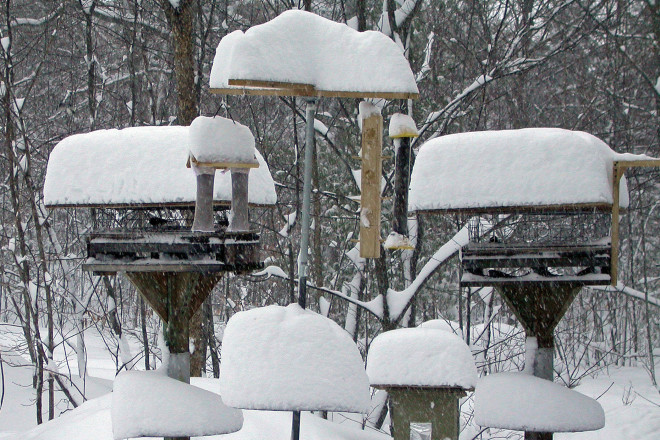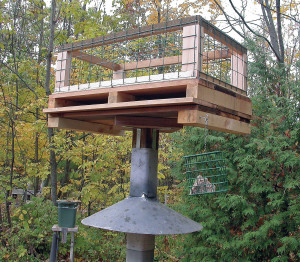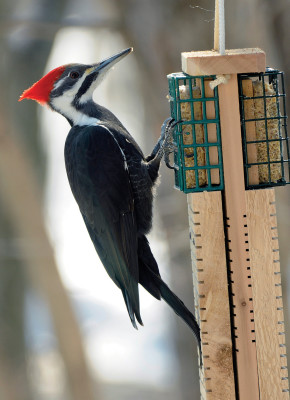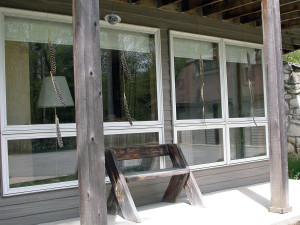Feeding Birds in the Winter
- Share
- Tweet
- Pin
- Share

Feeding wild songbirds in winter can be very rewarding and also challenging. Year-round feeding can be doubly gratifying, which is what Charlotte and I have been doing for many years.
To be perfectly honest, we don’t supply these creatures with food thinking we are helping them remain alive and healthy. We realize our desire to have the birds feeding nearby reflects selfishness. Daily records of seen species are kept and then filed for future reference. It is our opinion that watching them has taught us much about nature. By the way, once you begin a winter bird feeding program it is vital to continue at least until the snow has melted and weather has warmed up.
Here are some points to consider when feeding birds in winter.
Strange as this may sound, experience has proven that the closer to windows the feeders are placed, the fewer bird-window collisions there will be. If feeders are 25 or more feet from your home, as ours are, then you have to reduce the chances of bird fatalities against the windows.
It is the mirrored reflection of the sky, trees, etc. the birds see in shiny windows that lures them to fly there to safety, only to be killed against the immovable glass. Hanging items, such as hawk silhouettes, inside the glass does little or nothing to prevent the problem.
One very effective solution we use is obtaining Wild Turkey wing feathers from a hunter friend, attach the tip of the shafts to a strong string about two feet apart and suspend them in front of the problem windows. With the strings attached at the top of the window frame and loosely at the bottom, the feathers will dangle with the slightest breeze.
As for the feeders, I suggest first try to be creative and make some of them yourself. Even though we’ve had good success with various kinds of plastic tube-type feeders, our most effective are the two 20- by 30-inch wooden platforms fastened to stout posts so the feeding areas are at least five feet above the ground. These feeders should be at least eight or more feet from the nearest trees. Use a metal cone-shaped baffle, metal stove pipe, or some other device around the post to prevent squirrels and other mammals from climbing up.
Squirrels, for example, are very determined, agile and intelligent and often will somehow magically reach the bird food. They don’t call a squirrel the “Houdini of the mammal world” for nothing. (In case you decide to live-trap the Gray Squirrels and relocate them, bear in mind that nature abhors a vacuum. Different Gray Squirrels will soon move in to take their place!)
 In winter I use metal cages, with the mesh size being about 1½ by 2 inches. The wood-framed cage should generally match the size of the platform and be about 5 to 6 inches high. These cages will prevent Mourning Doves and most Blue Jays from entering the platform, but allows smaller species to easily enter, even Cardinals. Place a stout piece of waterproof plywood slightly larger than the size of the platform on top of the cage. Now you can wake up in the morning after a snowstorm, knowing there will be seeds available for the birds instead of being snow covered.
In winter I use metal cages, with the mesh size being about 1½ by 2 inches. The wood-framed cage should generally match the size of the platform and be about 5 to 6 inches high. These cages will prevent Mourning Doves and most Blue Jays from entering the platform, but allows smaller species to easily enter, even Cardinals. Place a stout piece of waterproof plywood slightly larger than the size of the platform on top of the cage. Now you can wake up in the morning after a snowstorm, knowing there will be seeds available for the birds instead of being snow covered.
If I had to narrow down the kinds of food offered for the birds to two, they’d be black oil sunflower seeds and beef suet. Woodpeckers, Nuthatches and surely the Black-capped Chickadees will consume the suet. Years ago it was easy to get beef suet free from some butchers. Times have changed and today nearly everyone who feeds birds uses various kinds of manufactured suet blocks which are easy to present to the birds using either homemade or purchased metal (plastic-covered) cages made expressly to hold the blocks.
Winter can be the perfect season for offering Niger seeds for species including Pine Siskins, Common Redpolls and American Goldfinches. For years we put out cracked corn, which quite a few species consumed, including the Red-bellied Woodpeckers. The more abundant Wild Turkeys became in our area, the more of a problem they presented. Finally we stopped offering cracked corn and not only the turkeys stopped coming, but also Red-winged Blackbirds, Common Grackles and a few other less desirable feeder birds.
For many years our most expensive bird food has been what we call “Marvel Meal,” a mixture of peanut butter, yellow corn meal and several other ingredients (see recipe on previous page). You should make your own feeder for presenting this attractive and very nutritious food.
We’ve found that white proso millet is excellent food and will be favored by Tree Sparrows and other wintering species such as Common Redpolls and Pine Siskins. I scatter it on the ground or on top of snow along with small amounts of Niger seeds.
Do your best to keep the feeders very clean; a solution of one part bleach to 10 parts water will help a lot. After cleaning, allow the feeders to dry thoroughly before restocking with seeds. The more birds you attract to feeders, the likelihood of attracting sick and diseased birds increases. If there is a significant increase in dead birds from infected feeders, take your feeders down and completely stop feeding the birds for at least a full year.
I am a firm believer in providing water for the birds. A plastic dish, such as those used under large potted plants, that’s at least three inches deep and 12 to 15 inches wide will work well. An excellent thermostatically-controlled submersible heater, such as those used in brooder houses for chickens, can be obtained quite easily from a good birdseed store. Again, keep the water container clean at all times.
Feeding birds in winter will very likely attract their predators, including hawks, falcons and shrikes. Bear in mind that, just as the songbirds you are feeding are protected by state and federal laws, so too are the predacious birds. By far the two most common in our region are the Sharp-shinned and the Cooper’s Hawks, both accipiters (ak-SIP-i-ters) that have short, wide wings and are extremely fast and explosive fliers for short distances.
I’ve planted a hedge of Eastern White Cedar trees very close to the feeders, kept trimmed to about seven or eight feet in height, into which the small birds can escape within a split second when the need arises. This has helped keep bird causalities down to a bare minimum. I especially like the White Cedar because of its very smooth foliage, which in turn is much easier on the birds.
We’re big on planting flowers in our front yard (close to the bird feeders) to attract butterflies each summer. One of their favorite plants is the Tithonia, either the short or the tall variety. Come fall, we allow the dried and sturdy plants to remain standing. Much to our surprise especially the American Goldfinches find the seeds to their liking and will completely strip the plants of the nourishing food.
I hope you decide to take up feeding the wild songbirds in winter. Gradually you’ll learn from your mistakes, improve not only your management of your bird-feeding station but also your knowledge and love of the birds and other wild creatures. Become a true “partner in nature!”
The Lukes’s Marvel Meal Suet Mix
2 cups lard (no substitutes) [Charlotte Lukes (CL) buys a one-pound box at the grocery store near the meat coolers.]
2 cups chunky peanut butter (CL uses a whole 18 oz. jar)
4 cups yellow whole-grain cornmeal
4 cups quick oats (store brand is fine)
2/3 cup white sugar
2/3 cup white flour (winter) OR 1 cup white flour (summer)
Slowly melt the lard in a medium pot on the stove, stirring frequently; use a low heat setting so it doesn’t burn. When it’s hot, stir in the peanut butter until melted.
(You can also melt the lard in a large heatproof glass measuring cup in the microwave for one minute on full power. Stir and cook another minute or 45 seconds until melted. Stir well. Add the peanut butter and cook another minute, stirring until all is melted and blended.)
Then, pour this lard/peanut butter mixture into a large stainless steel or enamel bowl and mix in the rest of the ingredients. Spoon the mixture into several rectangular containers with tight-fitting lids, and place in the refrigerator for storage.
Use a small metal spatula to scoop out the mixture from the storage containers and press it into the appropriate feeders. You can also cut the mixture into slabs and put into mesh bags; hang bags for the birds where the squirrels, Blue Jays, dogs and raccoons cannot get at them.
The nice thing about Marvel Meal is it doesn’t melt in hot weather, so it can be used throughout the year.
Photography by Roy Lukes.


